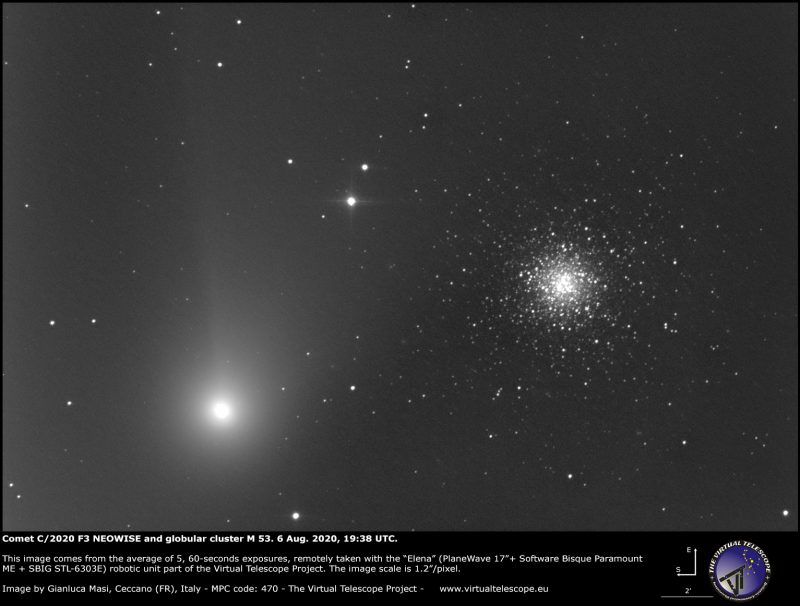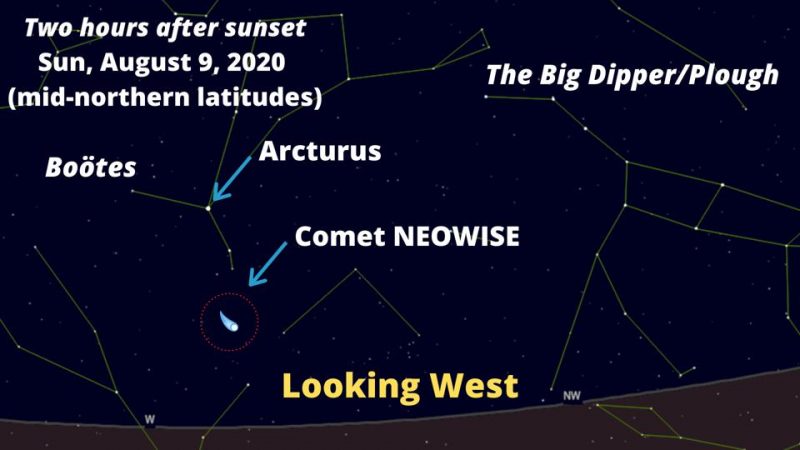

Comet C/2020 F3 NEOWISE and globular cluster Messier 53, August 6, 2020, via Virtual Telescope.
While slowly leaving the inner solar system, Comet C/2020 F3 NEOWISE is surfing our skies, having very interesting encounters on our sky’s dome with stars and deep-sky objects. On August 6, 2020, the Virtual Telescope Project caught it with globular star cluster Messier 53.
The image above comes from the average of five, 60-seconds exposures, unfiltered, remotely taken with the Elena (PlaneWave 17?+Paramount ME+SBIG STL-6303E) robotic unit available as part of the Virtual Telescope Project. The sky was bright because of twilight.
Of course, this is just a matter of perspective: comet C/2020 F3 was at about 140 million kilometers (about 90 million miles) from us, while the Messier 53 globular cluster is placed at 58,000 light-years. To put these distances on the same scale, traveling at the speed of light, you would reach the comet in almost 8 minutes. Then you would need 58,000 years to reach the cluster!
We at the Virtual Telescope Project covered comet NEOWISE extensively: the images we already released are available for you to enjoy.

How to see Comet NEOWISE on August 9, 2020. Writing in Forbes, Jamie Carter wrote on August 6, 2020: “The comet can be found above the western horizon as soon as it gets dark, around 90 minutes after sunset. Do remember that you need binoculars because it’s now almost impossible to find the comet with your unaided naked eyes even in dark skies. 10×50 binoculars are a good option, though anything you already have, or can borrow, is probably good enough.” Image via Jamie Carter/ Cartes du Ciel/ Forbes.
Bottom line: A photo from the Virtual Telescope Project in Rome of Comet C/2020 F3 NEOWISE and the globular star cluster M52.
from EarthSky https://ift.tt/2F76hZ3


Comet C/2020 F3 NEOWISE and globular cluster Messier 53, August 6, 2020, via Virtual Telescope.
While slowly leaving the inner solar system, Comet C/2020 F3 NEOWISE is surfing our skies, having very interesting encounters on our sky’s dome with stars and deep-sky objects. On August 6, 2020, the Virtual Telescope Project caught it with globular star cluster Messier 53.
The image above comes from the average of five, 60-seconds exposures, unfiltered, remotely taken with the Elena (PlaneWave 17?+Paramount ME+SBIG STL-6303E) robotic unit available as part of the Virtual Telescope Project. The sky was bright because of twilight.
Of course, this is just a matter of perspective: comet C/2020 F3 was at about 140 million kilometers (about 90 million miles) from us, while the Messier 53 globular cluster is placed at 58,000 light-years. To put these distances on the same scale, traveling at the speed of light, you would reach the comet in almost 8 minutes. Then you would need 58,000 years to reach the cluster!
We at the Virtual Telescope Project covered comet NEOWISE extensively: the images we already released are available for you to enjoy.

How to see Comet NEOWISE on August 9, 2020. Writing in Forbes, Jamie Carter wrote on August 6, 2020: “The comet can be found above the western horizon as soon as it gets dark, around 90 minutes after sunset. Do remember that you need binoculars because it’s now almost impossible to find the comet with your unaided naked eyes even in dark skies. 10×50 binoculars are a good option, though anything you already have, or can borrow, is probably good enough.” Image via Jamie Carter/ Cartes du Ciel/ Forbes.
Bottom line: A photo from the Virtual Telescope Project in Rome of Comet C/2020 F3 NEOWISE and the globular star cluster M52.
from EarthSky https://ift.tt/2F76hZ3

Aucun commentaire:
Enregistrer un commentaire